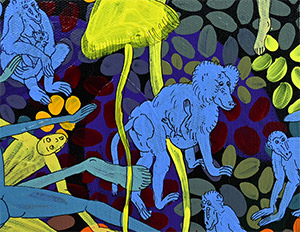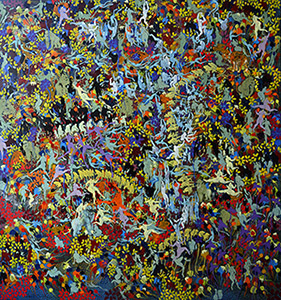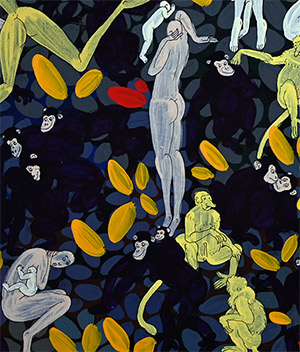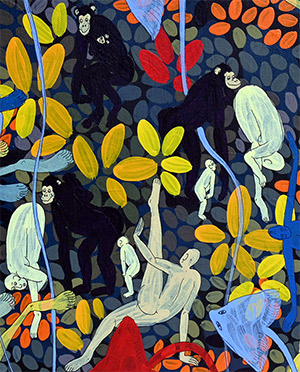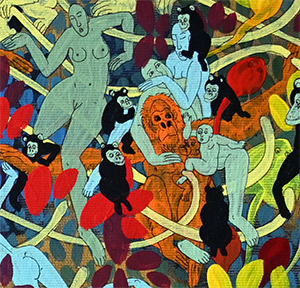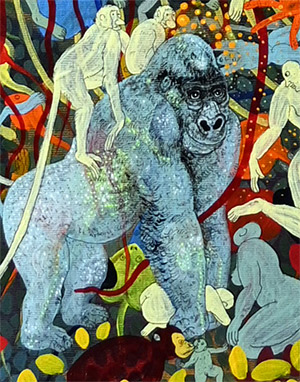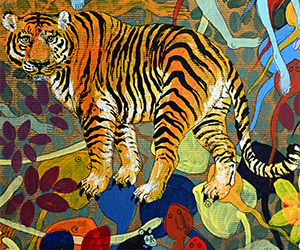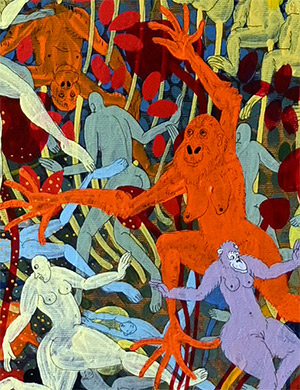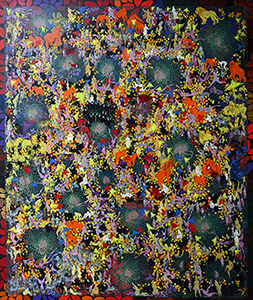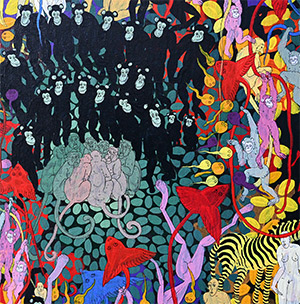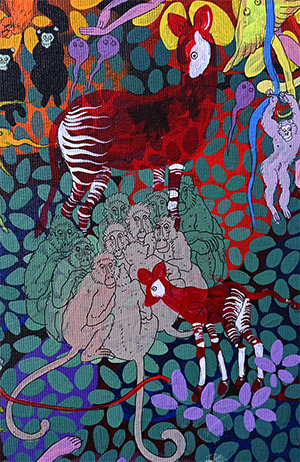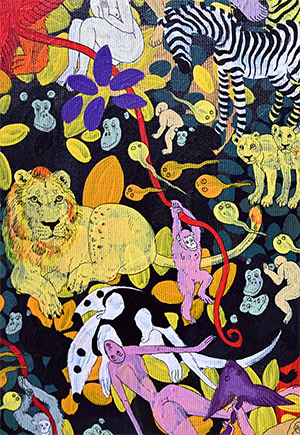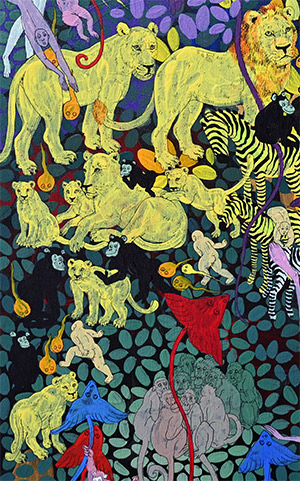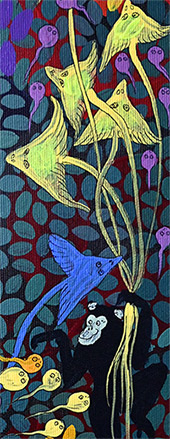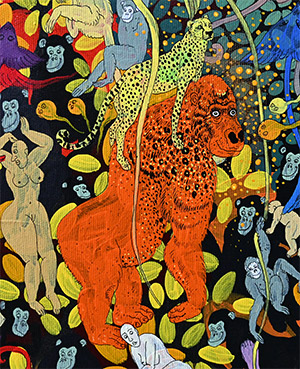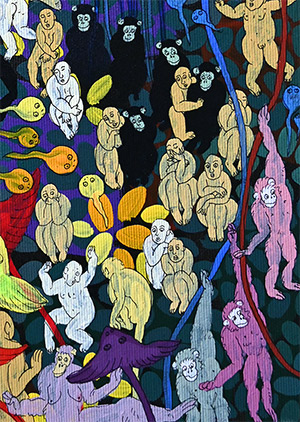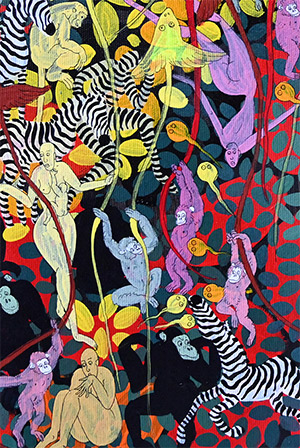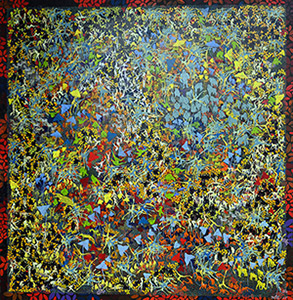
Kingdom of the Apes – 1 by OtGO 312 x 312 cm
I
wanna be like you! is singing King Louie in Walt Disney's cartoon “The Jungle Book”
(1967). The dancing Monkey King wants to be, go and talk like a human
being and negotiate a deal to elicit the secret of the 'red flower', of
making a fire, from the boy Mowgli. In return, the eager to learn
orangutan offers the human child that it can stay in the jungle. But in
the long run man has 'lost' little in the jungle and in the face of
numerous dangers and despite his animal family, friends and protectors,
he is drawn to the human settlement. The adult viewer may wonder: Does
Mowgli's step across the threshold into 'civilization' amount to an
initiation rite? Is it some kind of banishment from paradise? Or is the
gap between evolution simply opening up here?
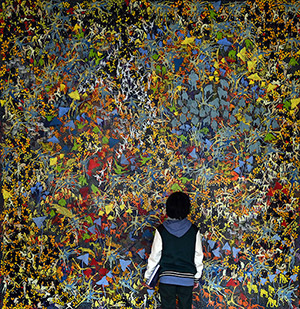
Detailed view: Kingdom of the Apes – 1/3 312 x 312 cm
The painter OtGO plays with these questions in the three-part painting series Kingdom of the Apes (1/3 - 3/3, 2020/21, acrylic on canvas, private collections). It is unconventional because this time the wishes of collectors resulted in the extraordinary picture dimensions (312 x 312 and 190 x 160 cm). At the same time, from a formal point of view, these formats, their arrangement and the separate hanging locations do not correspond to the type of image that inherited the winged altar. But it was precisely the context in terms of content and the integrative message to the human species that they forged together in the studio as a three-panel picture, making them a contemporary and unconventional variant of the triptych. In addition, the subject arises from a personal soft spot for monkeys on the part of the artist, which he formed into a next picture idea while working on the swirling stream of life of Infinite 16 (2013-2020, acrylic on canvas 213 x 650 cm). He did not imagine any 'nicely sorted' jungle sections in which the 'naive' would still put their monkeys. Just think of Henri Julien Félix Rousseau's oil paintings, such as “Tropical Forest with Monkeys” (1910)1.
1 Oil on canvas, 129.5 x 159.5 cm, National Gallery of Art, Washington D.C. Another apt example is “The Merry Jesters”, 1906, oil on canvas, 145.7 x 113.3 cm, Philadelphia Museum of Art.
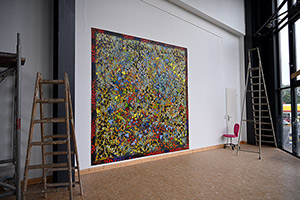
Studio OtGO: Kingdom of the Apes – 1/3 312 x 312 cm
OtGO's kingdom of the apes gathers the primate family before the eyes of the beholder, as if looking through a kaleidoscope full of bright colors, integrates friend and foe and assigns the genealogical branch to the human figures.
So it is exceptionally good to dare to venture into another cinematic excursion. Because it is not only in Walt Disney's cartoon worlds that a 'monkey dance' in the sense of King Louie' is raging. Regardless of OTGO's image idea, documentaries of the National Geographic Magazine with the same title can also be found under the English title The Kingdom of the Apes. And indeed, they do exist - in the Battle Lines episode, the ape kingdoms are located deep in the rainforests of Rwanda and Tanzania. 'Monkey kings' like Titus, a mighty silverback who has led and protected a large group of gorillas for more than 20 years, live there. Or the chimpanzee brothers Froyd and Frodo, who fight with each other for dynastic rule and have to defeat both rivals and diseases. You can see hierarchies and power structures in the respective 'ape society', which are characterized by violence, intrigue and fraud. The monkeys' ability to bring about decisions and also to demand them from the others seems to be 'political calculation'. This far exceeds everyday activities such as eating vegetarian food or hunting together or rearing the young in both groups. Last but not least, the sensitive, affectionate behavior of the togetherness and the physical closeness are impressive, for example when it comes to saying goodbye to the 'Gorilla King' when he dies. Then it becomes clear once again how closely the primates are related, that is, in particular, how close apes and humans really are.
Back to OtGO's first acrylic painting Kingdom of the Apes (1/3, 2020, 312 x 312 cm). In the detailed recordings of the video on the homepage, the image composition and structure that is characteristic of the artist become clear: the inner frame and the image ground are covered by a 'sea' of dense, ornamental leaf structures in different sizes, mostly in the primary colors red, yellow and blue on black. Numerous layers of paint form the figures using thin, black ink contours and the brightly colored paint. The figures condense, line up, overlap, network and act like organic nerve nodes that grow over the image carrier.
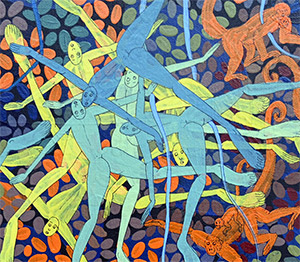
Detailed view: Kingdom of the Apes – 1/3
This flat figuration, which is related to the cartoon, can be found on all three paintings, just as the application of paint typically alternates glazes and opaque areas, which creates tension on the surface of the picture. OtGOs' signatures made up of a thumbprint and a vertical signature are placed in white between the background of the picture and the 'figure network'.
In the first picture, yellow and blue predominate in various nuances in the color scheme. Red tones and complementary light green create a heterogeneous balance. 'Sprinkles' are then the colors black and white. The human figures fit into the palette via a light incarnate as well as blue and yellow tones.
Central figures in the dense crowd of the picture field are precisely those primates, monkeys and human figures, to which the course of the text will be devoted in detail. Further animal figures can be successively determined: These include other mammals (zebras) and - surprisingly far from any wet element - also cartilaginous fish (rays) and reptiles (crocodile, alligator, turtle). The white and yellow, 'faceless' zebras are a popular motif in OtGO's works, as he particularly values this wild animal because of its inherent indomitable nature. The rays in the primary colors blue, yellow and red, on the other hand, have a structuring function, as they are able to link the layers of paint in the picture with one another.
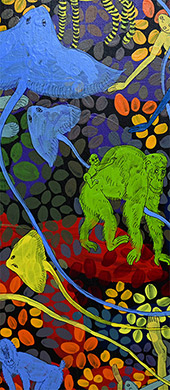
Detailed view: Kingdom of the Apes – 1/3
This happens through the lines of their extra-long tails and the leaf-shaped bodies, which the viewer thinks of threads and knots in a tapestry. Obviously, the rays also develop an ornamental quality that can be read in the broadest sense of art history as a contemporary reference to the plant ornamentation of Art Nouveau.
The crocodile, alligator and turtle are not only painted in yellow, but also come under a common taxon, the sauropsids, which (in addition to birds) also include the species of dinosaurs that were extinct in primeval times. In the picture they represent the enemies of the primates, which is realized by the representation of the open crocodile mouth with the threatening teeth.
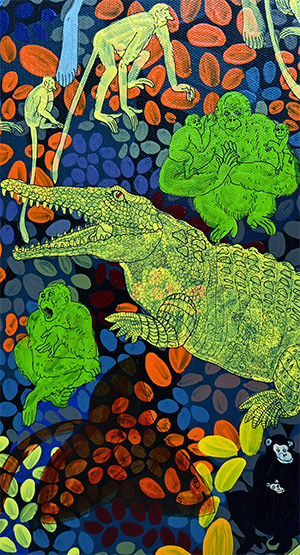
Detailed view: Kingdom of the Apes – 1/3
On the other hand, the painter levels out the danger with a wink when he shows that reptile and a green orangutan next to it, with the same facial expressions and feet, anthropomorphic like two philosophers in dialogue in the wilderness.
In addition, one would like to think that painting has quickly removed the boundary between sea and land (forest), which is so elementary for the process of the development of life, by bringing together the listed animal classes. Sometimes the figures are more reminiscent of abstract thought, whether represented individually or in formations, in their abundance of cosmic fog, groups of parachutists and artificial swimmers, than of the animal models in the wild. The painting technique and overarching image structure, on the other hand, once again suggest the impression of a colorful tapestry.
In view of the biodiversity and its unmanageable representation in the picture, the viewer involuntarily finds himself in the role of a monkey researcher on a tropical expedition through the 'forest of figures': First of all, it is about spotting the different species of monkeys on the large format, identifying them on the basis of their 'forms' and to assign 'colors' that hardly correspond to the conditions in nature. Starting with the real ancestor of King Louie, the orangutan, whose representatives surprisingly present themselves here in green and without royal dignity. Instead, they mimic court jesters by teasing the larger of the two crocodiles, the turtle and a ray, pulling by the tail (see left half of the picture). Truly royal striding, standing upright or sitting peacefully together in a large group, on the other hand, figurations of the gorilla appear in blue-green and yellow (mostly in the right half of the picture).
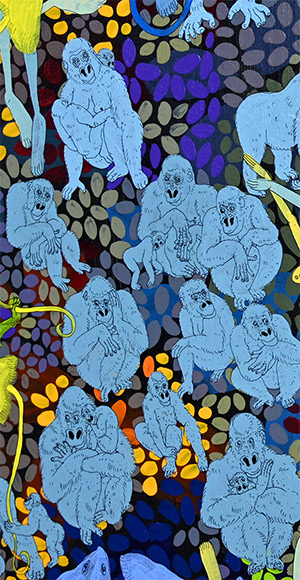
Detailed view: Kingdom of the Apes – 1/3
In the 'royal entourage' there are also blue baboons (upper half of the picture)
and orange and white long-tailed macaques (lower and right edge of the picture). The white and blue Hanuman langurs stand out from the crowd - they are pretty slender monkeys with a black face (upper left half of the picture).
The 'courtiers' also include two closely related families who are difficult to distinguish on the canvas due to their black color and almost identical appearance: chimpanzees and bonobos (dwarf chimpanzees).
Sources (selection)
Bild. Gorilla baby born in Berlin Zoo/ Youtube (March 12th, 2021).
Artist talk with OTGO on March 8th, 2021.
museenkoeln/ Nana oder Niki? Bild der 42. Woche 15-21. Oktober 2007 (21.03.2021).
National Geographic Channel Wild/ Ape Genius , Documentary HD 2017. (https://www.youtube.com/watch?v=dKwlhVNish0 , 03.03.2021).
National Geographic Channel Wild/ Kingdom of the Apes, Battle Lines, Documentary HD 2018. (https://www.youtube.com/watch?v=oxU5BknIuSI, 12.03.2021).
naturhistorisches Museum Wien/ Venusforschung (21.03.2021).
The Jungle Book, I wanna be like you, Youtube (15.03.2021).
Zoo und Tierpark Berlin. Nachwuchs bei den Gorillas im Zoo Berlin (15.03.2021).

Detailed view: Kingdom of the Apes – 1/3 312 x 312 cm
The painter OtGO plays with these questions in the three-part painting series Kingdom of the Apes (1/3 - 3/3, 2020/21, acrylic on canvas, private collections). It is unconventional because this time the wishes of collectors resulted in the extraordinary picture dimensions (312 x 312 and 190 x 160 cm). At the same time, from a formal point of view, these formats, their arrangement and the separate hanging locations do not correspond to the type of image that inherited the winged altar. But it was precisely the context in terms of content and the integrative message to the human species that they forged together in the studio as a three-panel picture, making them a contemporary and unconventional variant of the triptych. In addition, the subject arises from a personal soft spot for monkeys on the part of the artist, which he formed into a next picture idea while working on the swirling stream of life of Infinite 16 (2013-2020, acrylic on canvas 213 x 650 cm). He did not imagine any 'nicely sorted' jungle sections in which the 'naive' would still put their monkeys. Just think of Henri Julien Félix Rousseau's oil paintings, such as “Tropical Forest with Monkeys” (1910)1.
1 Oil on canvas, 129.5 x 159.5 cm, National Gallery of Art, Washington D.C. Another apt example is “The Merry Jesters”, 1906, oil on canvas, 145.7 x 113.3 cm, Philadelphia Museum of Art.

Studio OtGO: Kingdom of the Apes – 1/3 312 x 312 cm
OtGO's kingdom of the apes gathers the primate family before the eyes of the beholder, as if looking through a kaleidoscope full of bright colors, integrates friend and foe and assigns the genealogical branch to the human figures.
So it is exceptionally good to dare to venture into another cinematic excursion. Because it is not only in Walt Disney's cartoon worlds that a 'monkey dance' in the sense of King Louie' is raging. Regardless of OTGO's image idea, documentaries of the National Geographic Magazine with the same title can also be found under the English title The Kingdom of the Apes. And indeed, they do exist - in the Battle Lines episode, the ape kingdoms are located deep in the rainforests of Rwanda and Tanzania. 'Monkey kings' like Titus, a mighty silverback who has led and protected a large group of gorillas for more than 20 years, live there. Or the chimpanzee brothers Froyd and Frodo, who fight with each other for dynastic rule and have to defeat both rivals and diseases. You can see hierarchies and power structures in the respective 'ape society', which are characterized by violence, intrigue and fraud. The monkeys' ability to bring about decisions and also to demand them from the others seems to be 'political calculation'. This far exceeds everyday activities such as eating vegetarian food or hunting together or rearing the young in both groups. Last but not least, the sensitive, affectionate behavior of the togetherness and the physical closeness are impressive, for example when it comes to saying goodbye to the 'Gorilla King' when he dies. Then it becomes clear once again how closely the primates are related, that is, in particular, how close apes and humans really are.
Back to OtGO's first acrylic painting Kingdom of the Apes (1/3, 2020, 312 x 312 cm). In the detailed recordings of the video on the homepage, the image composition and structure that is characteristic of the artist become clear: the inner frame and the image ground are covered by a 'sea' of dense, ornamental leaf structures in different sizes, mostly in the primary colors red, yellow and blue on black. Numerous layers of paint form the figures using thin, black ink contours and the brightly colored paint. The figures condense, line up, overlap, network and act like organic nerve nodes that grow over the image carrier.

Detailed view: Kingdom of the Apes – 1/3
This flat figuration, which is related to the cartoon, can be found on all three paintings, just as the application of paint typically alternates glazes and opaque areas, which creates tension on the surface of the picture. OtGOs' signatures made up of a thumbprint and a vertical signature are placed in white between the background of the picture and the 'figure network'.
In the first picture, yellow and blue predominate in various nuances in the color scheme. Red tones and complementary light green create a heterogeneous balance. 'Sprinkles' are then the colors black and white. The human figures fit into the palette via a light incarnate as well as blue and yellow tones.
Central figures in the dense crowd of the picture field are precisely those primates, monkeys and human figures, to which the course of the text will be devoted in detail. Further animal figures can be successively determined: These include other mammals (zebras) and - surprisingly far from any wet element - also cartilaginous fish (rays) and reptiles (crocodile, alligator, turtle). The white and yellow, 'faceless' zebras are a popular motif in OtGO's works, as he particularly values this wild animal because of its inherent indomitable nature. The rays in the primary colors blue, yellow and red, on the other hand, have a structuring function, as they are able to link the layers of paint in the picture with one another.

Detailed view: Kingdom of the Apes – 1/3
This happens through the lines of their extra-long tails and the leaf-shaped bodies, which the viewer thinks of threads and knots in a tapestry. Obviously, the rays also develop an ornamental quality that can be read in the broadest sense of art history as a contemporary reference to the plant ornamentation of Art Nouveau.
The crocodile, alligator and turtle are not only painted in yellow, but also come under a common taxon, the sauropsids, which (in addition to birds) also include the species of dinosaurs that were extinct in primeval times. In the picture they represent the enemies of the primates, which is realized by the representation of the open crocodile mouth with the threatening teeth.

Detailed view: Kingdom of the Apes – 1/3
On the other hand, the painter levels out the danger with a wink when he shows that reptile and a green orangutan next to it, with the same facial expressions and feet, anthropomorphic like two philosophers in dialogue in the wilderness.
In addition, one would like to think that painting has quickly removed the boundary between sea and land (forest), which is so elementary for the process of the development of life, by bringing together the listed animal classes. Sometimes the figures are more reminiscent of abstract thought, whether represented individually or in formations, in their abundance of cosmic fog, groups of parachutists and artificial swimmers, than of the animal models in the wild. The painting technique and overarching image structure, on the other hand, once again suggest the impression of a colorful tapestry.
In view of the biodiversity and its unmanageable representation in the picture, the viewer involuntarily finds himself in the role of a monkey researcher on a tropical expedition through the 'forest of figures': First of all, it is about spotting the different species of monkeys on the large format, identifying them on the basis of their 'forms' and to assign 'colors' that hardly correspond to the conditions in nature. Starting with the real ancestor of King Louie, the orangutan, whose representatives surprisingly present themselves here in green and without royal dignity. Instead, they mimic court jesters by teasing the larger of the two crocodiles, the turtle and a ray, pulling by the tail (see left half of the picture). Truly royal striding, standing upright or sitting peacefully together in a large group, on the other hand, figurations of the gorilla appear in blue-green and yellow (mostly in the right half of the picture).

Detailed view: Kingdom of the Apes – 1/3
In the 'royal entourage' there are also blue baboons (upper half of the picture)
and orange and white long-tailed macaques (lower and right edge of the picture). The white and blue Hanuman langurs stand out from the crowd - they are pretty slender monkeys with a black face (upper left half of the picture).
The 'courtiers' also include two closely related families who are difficult to distinguish on the canvas due to their black color and almost identical appearance: chimpanzees and bonobos (dwarf chimpanzees).
Sources (selection)
Bild. Gorilla baby born in Berlin Zoo/ Youtube (March 12th, 2021).
Artist talk with OTGO on March 8th, 2021.
museenkoeln/ Nana oder Niki? Bild der 42. Woche 15-21. Oktober 2007 (21.03.2021).
National Geographic Channel Wild/ Ape Genius , Documentary HD 2017. (https://www.youtube.com/watch?v=dKwlhVNish0 , 03.03.2021).
National Geographic Channel Wild/ Kingdom of the Apes, Battle Lines, Documentary HD 2018. (https://www.youtube.com/watch?v=oxU5BknIuSI, 12.03.2021).
naturhistorisches Museum Wien/ Venusforschung (21.03.2021).
The Jungle Book, I wanna be like you, Youtube (15.03.2021).
Zoo und Tierpark Berlin. Nachwuchs bei den Gorillas im Zoo Berlin (15.03.2021).
